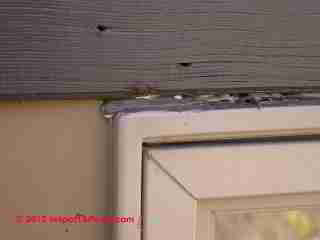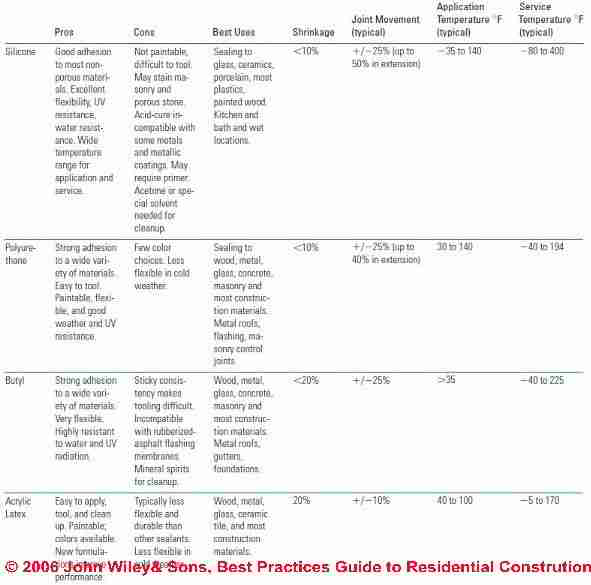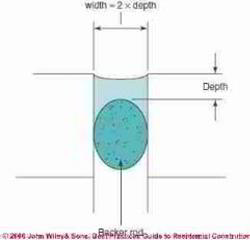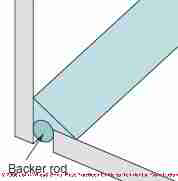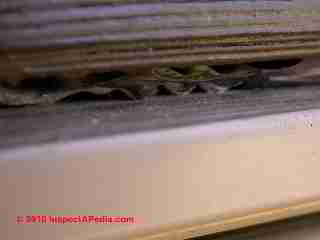 Best Practices Guide Exterior Caulks & Sealants for Buildings
Best Practices Guide Exterior Caulks & Sealants for Buildings
- POST a QUESTION or COMMENT about how to choose, use, & troubleshoot exterior caulks, paints, stains
Exterior caulks & sealants guide:
This article discusses the selection and proper application of exterior caulks and sealants on buildings.
This article series discusses best practices construction details for building exteriors, including water and air barriers, building flashing products & installation, wood siding material choices & installation, vinyl siding, stucco exteriors, building trim, exterior caulks and sealants, exterior building adhesives, and choices and application of exterior finishes on buildings: paints, stains.
Our page top photo of an open caulk joint over a window demonstrates that even with the best-performing sealants on the market, workmanship remains critical if the sealant (or caulk) is going to actually work to keep water out of the structure.
InspectAPedia tolerates no conflicts of interest. We have no relationship with advertisers, products, or services discussed at this website.
Best Practices Guide to Caulks & Sealants for Building Exterior Use
Adapted/paraphrased with permission from Best Practices Guide to Residential Construction (Steve Bliss, J Wiley & Sons) . Steven Bliss.
While no residential exteriors should rely solely on caulks and sealants to keep water out, many details require caulk either to mask an expansion joint between materials or as the first line of defense against leakage.
Article Contents
Table of Caulk & Sealant Types & Applications
When choosing a caulk or sealant (another name for a high-performance caulk), look for a product that will bond well to the substrate materials and be sufficiently flexible to tolerate the anticipated movement (Table 1-13).
Table 1-13: Caulk & Sealant Performance below summarizes the properties of different types of caulks and sealants. [Click any table or image to see an enlarged, detailed version.]
[Click to enlarge any image]
Caulk & Sealant Standards & Specifications
For critical joints where movement is anticipated, choose a caulk that complies with ASTM C920 and is rated for +/- 25% movement.
ASTM C920 indicates that the sealant is highly weather-resistant, durable, and shrinks no more than 10%. For stationary joints, a +/- 12.5% rating for joint movement is acceptable.
As we comment at RADON REMOVAL INDOORS, HOW-TO, when sealing gaps and cracks, you should seal smaller holes with a high-grade elastomeric sealant conforming to ASTM C920-87.
- ASTM C920 Standard Specification for Elastomeric Joint Sealants, available from astm.org, Excerpts from the standard abstract:
- This specification covers the properties of a cured single- or multicomponent cold-applied elastomeric joint sealant for sealing, caulking, or glazing operations on buildings, plazas, and decks for vehicular or pedestrian use, and types of construction other than highway and airfield pavements and bridges.
A sealant qualifying under this specification shall be classified as to type, grade, class and use as follows: type S - a single-component sealant, type M - a multicomponent sealant, grade P - a pourable or selfleveling sealant, grade NS - a nonsag or gunnable sealant, class 100/50, class 50, class 35, class 25, class 12.5, use T, use NT, use I, use M, use G, use A, and use O. ... [ additional text provided at REFERENCES] - 7.1 This specification covers several classifications of sealants as described in Section 4 for various applications. It should be recognized by the purchaser or design professional that not all sealants meeting this specification are suitable for all applications and all substrates.
It is essential, therefore, that the applicable type, grade, class, and use be specified so that the proper classification of sealant is provided for the intended use. Test methods relate to special standard specimen substrates of mortar, glass, and aluminum. If tests are required using substrates in addition to or other than the standard, they should be so specified for testing. - 1.1 This ASTM specification covers the properties of a cured single- or multicomponent cold-applied elastomeric joint sealant for sealing, caulking, or glazing operations on buildings, plazas, and decks for vehicular or pedestrian use, and types of construction other than highway and airfield pavements and bridges.
- 1.2 A sealant meeting the requirements of this specification shall be designated by the manufacturer to be one or more of the types, classes, grades, and uses defined in Section 7.
- This specification covers the properties of a cured single- or multicomponent cold-applied elastomeric joint sealant for sealing, caulking, or glazing operations on buildings, plazas, and decks for vehicular or pedestrian use, and types of construction other than highway and airfield pavements and bridges.
Caulk Joint Design to Avoid Failures: Ideal Joint Shape & Caulk Joint Specifications
Just as important as choosing the right caulk or sealant for the job is paying attention to how the caulk bead is applied.
The best quality caulk will fail if applied 1 inch thick and bonded on three sides of the joint. Our photo (above left) of caulk over a building window shows another view of the poor workmanship in our page top photo, and explains that over this window there is a risk of building leaks.
The ideal caulk joint where movement is anticipated is an hourglass shape about twice as wide as it is deep (see Figure 1-37).
This shape allows a caulk bead to stretch without either failing in “adhesion” to the substrate materials or failing in “cohesion” by tearing itself.
A good rule-of-thumb is that a caulk joint should be four times the width of the anticipated movement, limiting the sealant’s stretching to 25%. For most residential building details, this requires at least a 1/4-inch-wide joint.
In general, the sealant should be no more than 1/2-inchdeep. For deep joints, it is best to pack the joint with abacker rod, a flexible foam material that controls the depth of sealant and shapes it into the hourglass profile.
Backer rod is made of either open-cell or closed-cell foam and comes in diameters from 1/4-inch to as much as 2 inches.
In wet locations, such as concrete control joints, use closed-cell foam, since it will not absorb water. Use a backer rod a little bigger than the joint being sealed.
Bond Breakers - Use of Backer Rods in Wide Caulk Joints
In addition to controlling the depth and shape of a caulk bead, the backer rod acts as a “bond breaker,” preventing the caulk from sticking to the back side of the joint. A three-sided caulk joint tends to tear when the materials move. Corner joints subject to movement are also prone to fail.
For corner joints, use a small diameter backer rod or any other material that will not bondto the sealant. Plastic and foam tapes sold for weather stripping can work in corners (see Figure 1-38). [Click image for additional details].
Cleaning and Priming Requirements for Successful Caulk & Sealant Use
Since dirt, debris, and loose paint act as bond breakers, sealing to a dirty or flaking joint will fail when the joint moves. Also, the joint should be dry unless using a sealant approved for damp surfaces, such as some polyurethanes and some of the newer synthetic-rubber “Kraton” type sealants.
Do not use compressed air to clean the joints unless a line filter is also used, since the oil from the compressor may coat the joint, interfering with the bond. Although priming is not required for most sealants used in residential construction, some metals may need priming with acid-cure silicones. Consult the sealant manufacturer’s specifications.
Exterior Caulk Choices
Guide to Using Acrylic Latex Caulks & Sealants
The most economical and widely used caulking compound in residential work, acrylic latex caulks come in a wide variety of formulations and prices. To their credit, latex caulks are easy to apply, easy to tool, and can be cleaned before curing with water.
They bond moderately well to a wide variety of materials and have a long tooling time. When cured they are highly paintable, making acrylic latex popular for caulking paintable trim in both the interior and exterior.
Lower-end acrylic latex caulks do not have the same flexibility, temperature range, and long-term durability as butyl, polyurethane, or silicone. Newer premium products, however, promise performance on par with some of the high-performance sealants.
Added plasticizers make the material more flexible and other additives provide better UV and water resistance. For exterior work in joints subject to movement, look for an ASTM C920 rating and a rated joint movement of +/1 25%.
Most latex caulks cannot be applied under 40°F and should not be allowed to freeze in the tube or in place before cured. Also do not apply to wet surfaces or where rain is likely to fall before the caulk has a chance to fully cure.
Guide to Using Butyl Caulks & Sealants on buildings
Butyl is a high-quality, tough, rubber like sealant that is ideal for exterior jobs requiring a durable, watertight seal.
Because of its longevity, temperature range, and high UV resistance, it has long been used as a glazing compound. Notable for its stickiness, butyl bonds very well to a wide range of materials, including wood, concrete, masonry, glass, and metal. Its stickiness, however, can also make its application messy and tooling difficult. Before curing, it can be cleaned with mineral spirits.
Because of its good adhesion and water resistance, butyl is often used to seal metal gutters, metal roofing, and around foundations. It is approved for use below grade. Butyl should not be used, however, in contact with modified-bitumen flashing tapes or roofing membranes, which can degrade it.
Guide to Using Polyurethane Caulks & Sealants on Building Exteriors: Urethane Caulks
Polyurethane is a versatile, water-resistant, high performance sealant and has become the first choice of many contractors for exterior work. Polyurethanes provide excellent adhesion to a wide variety of materials from wood to masonry and remain flexible across a wide temperature range.
Furthermore, they are relatively easy to tool, and some brands accept wet tooling with soapy water. Tooling time is adequate and shrinkage minimal. Polyurethanes are available in only a few colors, but the cured sealant holds paint well.
Although polyurethane is not naturally UV-resistant, UV inhibitors give it good durability in exterior applications. Because of its aggressive bond, polyurethanes are good for sealing between different materials. Polyurethanes are widely used on metal roofs, concrete and masonry control joints, flashing, and exterior trim.
OSI Sealants, (Mentor OH, 800-999-8920) produces urethane caulks.
Guide to Using Silicone Caulks & Sealants on Building Exteriors
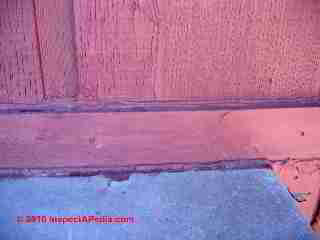 Silicones bond well to nonporous surfaces, such as glass,tile, and metals, and they are the most flexible sealants made. A good silicone will stretch as much as 50% of its
original width before tearing. Silicones are good in cold temperature work and can be applied from well below 0°F to over 100°F.
Silicones bond well to nonporous surfaces, such as glass,tile, and metals, and they are the most flexible sealants made. A good silicone will stretch as much as 50% of its
original width before tearing. Silicones are good in cold temperature work and can be applied from well below 0°F to over 100°F.
Once cured, silicone caulks and sealants can also tolerate temperatures from well below 0°F to about 400°F, or higher for special high-temperature formulations.
Unlike most sealants, silicone stays flexible when cold. Silicones are also very resistant to UV radiation and water, making them a good choice for exteriors as well as kitchens and baths.
The main disadvantages of silicone are that it is messy to work with, difficult to tool [notice the irregular bead of silicone caulk in our photo above], and does not hold paint well. Cleanup when wet requires acetone or special-order silicone solvent, and the residue is hard to remove when it is time to reapply.
Because of the residue, once you’ve sealed a joint with silicone, it is best to reseal with silicone as well. Silicone does not bond well to unpainted wood and can stain or degrade porous stone and masonry materials.
Silicones come in two types: acid-cure (acetoxy) and neutral-cure (sometimes called “noncorrosive” silicone). The acid-cure type has a distinctive vinegar like odor. Both types will stick well to glass, ceramics, and other nonporous surfaces. Acid-cure silicone, however, requires primer with most metals to bond well and to avoid corrosion. Neutral-cure silicones are compatible with most metals and metal finishes and bond somewhat better to wood.
-- Above text was adapted with permission from Best Practices Guide to Residential Construction (Steve Bliss, J Wiley & Sons) .
Choosing a Caulking Gun for Easy Fast Caulking Work & Good Results
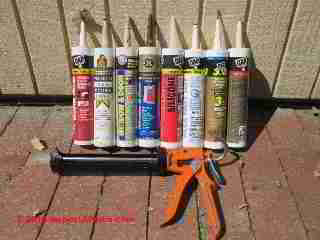 Details about choosing a caulk gun are at CAULK GUN TYPES, CHOICES. Excerpts are below.
Details about choosing a caulk gun are at CAULK GUN TYPES, CHOICES. Excerpts are below.
- Stamped-steel caulk guns (first caulk gun at left in the group of four below) Watch out Most caulk gun producers offer durable heavy duty and good performing caulk guns, but for the "quick and dirty one-off job"
also offer homeowner-grade caulk guns made of stamped metal that we find, at least in some cases, do not last long. We call these "disposable" caulk guns.
With the absolutely cheapest grades of these caulk guns we find that very quickly the gun goes in the trash after a strong squeeze has bent the trigger handle, or the plunger mechanism keeps slipping rather than forcing caulk out of the cartridge or tube. - Manual caulk guns, heavy duty models for homeowner and moderate construction use (second from left below): we much prefer the caulk cartridge type caulk gun shown in our photograph (above left and below, second from left)).
This type of caulking gun has a strong steel body, cast iron handle, and a plunger mechanism that does not slip when pushing against a recalcitrant tube of caulk.
Like many models this caulk gun includes a wire to open the foil seal found in the tops of some caulk tubes and of course a cutter to snip off the caulk tube tip. - The hooked caulk pushrod end forms a convenient ladder hook for the tool. Newborn produces a heavy duty professional NBC250 caulk gun of this type. A lighter version with an open cartridge body (third from left below) also performed acceptably but not as well as our preferred caulk gun.
Caulking Problems, Discussion, Possible Solutions
Question: how to get better results using silicone bath tub and tile caulk
(Oct 21, 2011) Ron said:
I have used silicone in the past and have found its performance to be lacking. I have used silicone to seal pvc windows and trim together, to add a preventive measure to my installation. Even though the application is approved on the tube I find that the expansion and contraction ratios of the pvc soon depletes the silicone of its adhesive nature and fails within a year or so.
Also I have read that silicone after curing doesn't allow anything to adhere to it, not even silicone.
So if I have a silicone joint that has failed I cant repair the joint until all of the silicone has been removed, even a thin film. Since not all surfaces will tolerate an acetone cleanup, on occasion I have had to sand the application to insure a good bond.
Indoor in showers it is especially difficult to prep the surface for a silicone repair. I Have tried numerous solvents but I am limited to what will not harm the tub surround or the sealer in the tile. I also find that the silicone based sealers for tile grout don't allow for a strong bond for much of anything to adhere to it.
I am explaining this because I would like to know some of the preferred sealing methods for common repairs, i.e. tub surrounds tile floors pvc windows and exterior pvc trim. Also how to prepare such surfaces in a way that would accept a bond from silicone or a poly.
As I stated before sometimes a solvent cannot be used, like on stucco or wood without compromising the integrity of the substrate.
I am very happy to have discovered your website and will use you often as well as share you with my friends. Keep up the good work!
Reply:
Thanks Ron. Steve Bliss made some suggestions in the article above.
When I'm using any caulk in a bathroom, because I hate doing it twice, I cut away old caulk with a single edged razor blade or a similar tool, then clean the surface with a clean rag and alcohol before applying the caulk. You could use other cleaners but don't want to leave any surface deposit.
Soap scum can be sneaky - leaving a deposit on what looks-like clean ceramic tile, as can oils used in the bath in body wash, after-bath skin lotions, and some hair treatments.
I've used acetone too but don't recommend it in general as when used in quantity (more than removing fingernail polish) it's a more dangerous chemical and is more easily absorbed through the skin - for dopes like me who used to work with it bare-handed.
The only trouble I've had with sealant failures after this careful preparation was when I used a sanded caulk to match adjacent tile grout at the wall-to-tub joint and where I asked the caulk to bridge too wide a gap. As the sealant dries it shrinks and cracks.
Question: how to seal a sewer pipe to the septic tank
2 Feb 2015 Bill said:
what do you recommend for sealing a plastic sewer drain pipe into the septic tank at the entry to the tank ( ABS to concrete tank ) ?
Reply:
Concrete for large openings, silicone sealant on clean surfaces for small ones.
Be sure to remove all soil at the tank opening or your bond may leak.
Reader Question: how to seal windows & doors in a Scottish Red Sandstone Cottage
9 Feb 2015 Rick said:
What is the Best exterior caulk sealant to use in the following application. I am fitting sash and case pine framed wooden double glazed windows into a red sandstone cottage. The cottage was built in 1834 and the sandstone is 18" - 24" thick. The Red Sandstone is a local stone to the east coast of Scotland. It can be very porous and has a tendency to crumble against the 'more firm less flexible' caulks. Suggestions and reasons for would be appreciated thanks.
Reply:
Good question, Rick. If the sandstone is very soft or friable I would not trust any conventional sealant. I'd expect the sealant just to bond with the loose surface and thus not to be durable.
How did people set windows and doors into walls built of this stone a hundred years ago? Perhaps you or I can find a building conservator who knows the answer.
For a modern approach you may need to treat the sandstone first then use a sealant.
See this reference which is my first choice:
- Young, Maureen, Pauline Cordiner, and Matthew Murray. Chemical consolidants and water repellents for sandstones in Scotland. Historic Scotland. Scottish Conservation Bureau. TCRE Group, 2003.
For background and additional detail
- Mitchell, David J., and David E. Searle. Stone Deterioration in Polluted Urban Environments. Science Publishers Inc., 2003.
- Mykura, W. "Old Red Sandstone." Geology of Scotland (1983): 205-51.
- Also see MASONRY FACADE / WALL, LINTEL & BROWNSTONE DAMAGE
And if fungal contamination or deterioration is a problem - as it is on some existing buildings built using Scottish sandstone, see
- Wakefield, R. D., M. Young, K. Tonge, and D. Urquhart. "Effects and efficacy of some masonry biocides applied to Scottish sandstone in the control of biological growths: current studies." In Conservation science in the UK: preprints of the meeting held in Glasgow, May 1993, pp. 15-19. James & James Science Publishers Ltd., 1993.
- Wakefield, Rachael D., Melanie S. Jones, M. Jeff Wilson, Maureen E. Young, Keith Nicholson, and Dennis CM Urquhart. "Investigations of decayed sandstone colonised by a species of Trentepohlia." Aerobiologia 12, no. 1 (1996): 19-25.
Reader follow-up:
18 Feb 2015 Rick said:
Thanks for the great resources. IIm off to do my research before deciding what the best approach is. Your question about what they used 100 plus yrs ago is a great place to start. Those builders knew a thing or two about the properties of the red sandstone. They knew it was both porous a breathable. It would get wet in the rain but dry out in the wind and sun.
The sandstone itself would regulate humidity and dampness. One of the biggest problems in recent years has been applying cement based mortars to the joints which traps moisture in, which then creates dampness and increased humidity.
The old lime mortars which are porous after application helped to decrease joint crumbling, maybe I should investigate that too. thanks again for the resources I'm looking forward to finding the best solution. - Kind Regards Rick
Reply:
We agree, Rick. An analagous problem I've seen in both the U.K. and in North America is the selection of modern mortars to re-point old brick walls. The harder modern mortar often leads to brick damage from its different response to temperature and moisture variations, and it also often is such a poor match for the original mortar colour and texture that it's nothing short of a mess.
Here's an example
discussed at BRICK STRUCTURAL WALLS LOOSE, BULGED
I've also seen some rather horrible attempts at "repairing" spalled brick walls and lost mortar from various masonry walls using caulk.
Where to Buy Exterior Caulks and Sealants
Construction Sealant (Caulks) Suppliers & Products
- Albion, 1250 North Church Street, Moorestown, New Jersey 08057-1102 http://www.albioneng.com/, 856-235-6688
- Chemrex www.chemrex.com
- Newborn caulking guns, distributed by Jamestown JD Distributors - http://www.jamestowndistributors.com
Polyurethanes and other high-performance sealants
- 3M - 800-234-8068
- Bostik - Chem-Calk urethane caulk - 414-774-2250
- DAP www.dap.com - 800-543-3840
- Tremco - Velcum urethane caulk - 800-321-7906
- Macklanburg-Duncan - Sika and Sikaflex caulks - 800-654-8454 (widely used in sealing concrete wall and floor slab cracks in the radon mitigation industry)
- OSI Sealants
These companies produce urethane caulks used widely on masonry surfaces and in the automotive industry.
Acrylic latex caulks
- Dow Corning Sealants www.dowcorningsealants.com
- Silicone sealants
- GE Silicones - www.gesilicones.com Silicone sealant
- Geocel Corp - www.geocelusa.com Acrylic latex, tripolymer, copolymer, Kraton, and clear sealants
- Macklanburg-Duncan - www.mdteam.com Acrylic latex sealants
- OSI Sealants Inc - www.osisealants.com Polyseamseal PVA-based caulk. Pro Series includes latex, polyurethane, and Kraton sealants.
- Phenoseal - www.phenoseal.com - Phenoseal vinyl adhesive caulk
- Red Devil www.reddevil.com Acrylic, silicone, and butyl sealants
- Sashco Sealants www.sashco.com Big Stretch and Mor-Flexx water-based sealants, Lexel Kraton sealant
- Sika Corp www.sikaconstruction.com Complete line of Sikaflex polyurethane-based sealants, butyl sealant
- Tremco Inc. www.tremcosealants.com High-performance, architectural-grade sealants,
- UGL www.ugl.com Acrylic latex caulks
- White Lightning www.wlcaulk.com Tripolymer, butyl, polyurethane, silicone, elastomeric, and other high-performance sealants
Exterior Adhesives
- Abatron EpoxyWood Repair/Restoration 5501 - 95th Avenue, Kenosha, WI 53144 USA Tel: (262) 653-2000
Fax: (262) 653-2019, For orders: (800) 445-1754 Abatron provides a wide range of wood & building restoration epoxy products including a low-viscosity system that penetrates and solidifies rotted wood and a thicker wood repair putty type epoxy.
Epoxy, BestBond polyurethane glue - Ambel www.excelglue.com Excel polyurethane glue
- Elmer’s Products www.elmers.com Yellow glues, ProBond polyurethane glue
- Custom-Pak Adhesives www.custompak.com Resorcinol and yellow glues
- DAP Inc. www.dap.com Weldwood contact cement, resorcinol, and construction adhesives Resources 49
- Franklin International www.titebond.com Titebond yellow glue, Liquid Hide Glue, and construction adhesives
- Gloucester Co. Inc. www.phenoseal.com Phenoseal adhesive caulk
- Gougeon Brothers www.westsystem.com West System epoxy
- Gorilla Group www.gorillaglue.com Gorilla polyurethane glue
- MACCO Adhesives www.liquidnails.com Liquid Nails construction adhesive
- SI Sealants www.osisealants.com PL400 construction adhesive
- System Three Resins www.systemthree.com Quick Cure epoxy
Reader Comments, Questions & Answers About The Article Above
Below you will find questions and answers previously posted on this page at its page bottom reader comment box.
Reader Q&A - also see RECOMMENDED ARTICLES & FAQs
On 2020-11-17 - by (mod) -
DM and other readers
Dryvit is a specific stucco product.
Sorry to have to duck a bit but I'm not certain you're asking about the specific product or generic "Stucco" or "synthetic stucco"
I always go back to the specific stucco system manufacturer's specifications for sealing joints as their requirements vary. Failure to follow the manufacturer's specs means no warranty coverage.
Dryvit Systems, Inc.
One Energy Way
West Warwick, RI 02893
Tel: 800-556-7752 (toll free)
Email: info@dryvit.com
Website: https://www.dryvit.com/
Dryvit lists several flashing products and coatings and of course a drainage plane or mat, but no sealants at a wall-concrete abutment;
I suspect that's a design constraint. I would avoid having to butt stucco down to a flat roof or other surface.
On 2020-11-17 by dm francis
What is the best sealant to use for sealing a dryvit siding and concrete ( bottom of dryvit around base)
On 2017-07-26 by Damian
I applied polyurethane caulking in some joints in precast concrete walls and inside the polyurethane formed air bubbles like gruyere cheese, why do you think this happpend?
On 2017-05-29 - by (mod) -
David,
I don't think that a cylinder caulk should be necessary to keep birds out of a roll up door. The opening 4 Birds is going to be a bit larger than that. I would take a look to see where they are getting in and then I would purchase some galvanized wire mesh or hardware cloth to Simply fix across that opening.
On 2017-05-29 by David
Have a store. Have an old roll down door. No longer in use, its a storage room now. Some how birds keep getting into the store. What can I use to seal the door.
Thank You, so much for your help...
On 2017-04-30 by Alan Harris
I am on the HOA board of a condo complex. 3 buildings have painted wood siding and one has Hardie Board. Traditionally the corner joints of the buildings have been caulked (unknown type) but the material has only lasted a year or two without cracking, shrinking and creating gaps.
The buildings are at 9500 feet altitude in Colorado and exposed to snow and cold in the winter and bright summer sun. What type of sealant might perform better and for a longer time? Thank you.
On 2016-10-26 by Lorraine Penhos
Just bought new house and there is moisture appearing on inside wood frame windows. What Materials would be best to use to seal. Outside of home is brick.
(Feb 18, 2015) Rick said:
Thanks for the great resources Dan Joe. I'm off to do my research before deciding what the best approach is.
Your question about what they used 100 plus yrs ago is a great place to start. Those builders knew a thing or two about the properties of the red sandstone.
They knew it was both porous a breathable. It would get wet in the rain but dry out in the wind and sun.The stone itself would regulate humidity and dampness One of the biggest problems in recent years has been applying cement based mortars to the joints which traps moisture in, which then creates dampness and increased humidity.
The old lime mortars which are porous after application helped to decrease joint crumbling, maybe I should investigate that too. thanks again for the resources I'm looking forward to finding the best solution. Kind Regards Rick
Reply:
We agree, Rick. An analagous problem I've seen in both the U.K. and in North America is the selection of modern mortars to re-point old brick walls. The harder modern mortar often leads to brick damage from its different response to temperature and moisture variations, and it also often is such a poor match for the original mortar colour and texture that it's nothing short of a mess.
Here's an example
inspectapedia.com/exterior/Brick_Tuckpoint_HughsonvilleNY_031_DJFcs.jpg
discussed at
inspectapedia.com/structure/Brick_Structural_Walls.htm
Question:
Aug 14, 2015) Lou Pereira said:
Hi, I would like to know if i need to use a specific type of caulking if I want to stick something like a drip edge onto a stucco wall?
Reply:
Lou I'm not quite sure what you are doing thus not sure what you need. An exterior construction adhesive may work better than a conventional sealant, but I'm nervous about gluing something to a wall - it may not be the correct approach to solve a leak or runoff problem. If you like use our email found at the page bottom CONTACT link to send me photos of the area and the problem.
Question: sealing around a hose bibb through a brick wall
(Aug 16, 2015) Mike P. said:
Hi: The water pipe to my sillcock (outside water spigot) rattles around loosely where it passes through my brick exterior wall, into the basement.
The mortar that held it has crumbled away over the years. Can I use an exterior caulk to plug the hole and will it be strong enough to keep the spigot securely in place? Also, down the road, if the spigot ever needs replacing (like to put a freeze-proof design in), will I be able to get it free, if caulk has been applied around it? Thanks for any reply.
Reply:
Hi Mike.
Oh you can get it free, alright, whether you seal the opening with cement or caulk. It'll take some chopping and hacking and will destroy the pipe or faucet where it passes through the wall, but then as the plan is to replace that component anyway, nothing much is lost.
Question: how to caulk around a space where the bottom of the concrete building tilt wall meets the concrete sidewalk or driveway
27 Oct 2015 Dave said:
I need to caulk around a space where the bottom of the concrete building tilt wall meets the concrete sidewalk or driveway. Caulking is concrete to concrete; the tilt wall is painted; the sidewalk and driveway are not painted. We will NOT be painting over the caulking.
One contractor tells me to use a Urethane Caulk, and another tells me to use a Silicon Caulk, such as Dow Corning 832 Silicon.
Lots of hot 90 plus degree weather in Dallas Texas.Which will last longest, and seal the best to keep water out? Silicon or Urethane Caulk? Lots of hot weather in Dallas Texas.
Reply:
IMO the urethane caulk will bond best between the two situations you describe. That is an overriding consideration in this case.
About sealant life: take a look at the manufacturer's promise right on the tube of caulk as even among the same sealant types the promised or warranty life varies among products and brand.
Take a look at Tremco's VulKEM 116 polyurethane sealant.
...
Continue reading at CAULKS, NONTOXIC or select a topic from the closely-related articles below, or see the complete ARTICLE INDEX.
Or see these
Recommended Articles
Suggested citation for this web page
CAULKS & SEALANTS, EXTERIOR at InspectApedia.com - online encyclopedia of building & environmental inspection, testing, diagnosis, repair, & problem prevention advice.
Or see this
INDEX to RELATED ARTICLES: ARTICLE INDEX to EXTERIORS of BUILDINGS
Or use the SEARCH BOX found below to Ask a Question or Search InspectApedia
Ask a Question or Search InspectApedia
Try the search box just below, or if you prefer, post a question or comment in the Comments box below and we will respond promptly.
Search the InspectApedia website
Note: appearance of your Comment below may be delayed: if your comment contains an image, photograph, web link, or text that looks to the software as if it might be a web link, your posting will appear after it has been approved by a moderator. Apologies for the delay.
Only one image can be added per comment but you can post as many comments, and therefore images, as you like.
You will not receive a notification when a response to your question has been posted.
Please bookmark this page to make it easy for you to check back for our response.
Our Comment Box is provided by Countable Web Productions countable.ca
Citations & References
In addition to any citations in the article above, a full list is available on request.
- Steve Bliss's Building Advisor at buildingadvisor.com helps homeowners & contractors plan & complete successful building & remodeling projects: buying land, site work, building design, cost estimating, materials & components, & project management through complete construction. Email: info@buildingadvisor.com
Steven Bliss served as editorial director and co-publisher of The Journal of Light Construction for 16 years and previously as building technology editor for Progressive Builder and Solar Age magazines. He worked in the building trades as a carpenter and design/build contractor for more than ten years and holds a masters degree from the Harvard Graduate School of Education. Excerpts from his recent book, Best Practices Guide to Residential Construction, Wiley (November 18, 2005) ISBN-10: 0471648361, ISBN-13: 978-0471648369, appear throughout this website, with permission and courtesy of Wiley & Sons. Best Practices Guide is available from the publisher, J. Wiley & Sons, and also at Amazon.com - Best Practices Guide to Residential Construction, by Steven Bliss. John Wiley & Sons, 2006. ISBN-10: 0471648361, ISBN-13: 978-0471648369, Hardcover: 320 pages, available from Amazon.com and also Wiley.com. See our book review of this publication.
- ASTM C920 Standard Specification for Elastomeric Joint Sealants, available from astm.org, Excerpts from the standard abstract:
- This specification covers the properties of a cured single- or multicomponent cold-applied elastomeric joint sealant for sealing, caulking, or glazing operations on buildings, plazas, and decks for vehicular or pedestrian use, and types of construction other than highway and airfield pavements and bridges. A sealant qualifying under this specification shall be classified as to type, grade, class and use as follows: type S - a single-component sealant, type M - a multicomponent sealant, grade P - a pourable or selfleveling sealant, grade NS - a nonsag or gunnable sealant, class 100/50, class 50, class 35, class 25, class 12.5, use T, use NT, use I, use M, use G, use A, and use O. A single-component sealant shall be a uniform mixture of a consistency suitable for immediate application by hand or pressure caulking gun or by hand tool. A multicomponent chemically curing sealant shall be furnished in two or more components. A single-component and multicomponent sealant, when stored in the original unopened container at temperatures of not more than 27°C (80°F) shall be capable of meeting the requirements for at least 6 months after date of delivery. Grade P (pourable or selfleveling) sealant shall have the required flow characteristics, it shall exhibit a smooth, level surface. Grade NS or gunnable sealant shall have the required flow characteristics such that when tested in vertical displacement. Type S, grade P, and grade NS sealant shall not be less than the given extrusion rate when tested. Type M and grade P sealant, when tested shall be not less than the given extrudable rate 3 h after mixing. Use T (traffic) sealant shall have a hardness reading, after being properly cured, of not less than 25 or more than 50 when tested. Use NT (nontraffic) sealant shall have a hardness reading, after being properly cured, of not less than 15 or more than 50 when tested. The sealant shall not lose more than 7 % of its original weight or show any cracking or chalking when tested. There shall be no transfer of the sealant to the polyethylene film when tested at 72 h. The sealant shall not cause any visible stain on the top surface of a white cement mortar base when tested. The adhesion and cohesion after cyclic movement shall be tested to meet the requirements prescribed. The adhesion-in-peel test shall be performed to meet the requirements precribed. The adhesion-in-peel after ultraviolet exposure through glass shall be determined to meet the requirements prescribed. The accelerated weathering effects, and sealants exposed to continuous immersion shall be determined to meet the requirements prescribed.
- This abstract is a brief summary of the referenced standard. It is informational only and not an official part of the standard; the full text of the standard itself must be referred to for its use and application.
- 7.1 This specification covers several classifications of sealants as described in Section 4 for various applications. It should be recognized by the purchaser or design professional that not all sealants meeting this specification are suitable for all applications and all substrates. It is essential, therefore, that the applicable type, grade, class, and use be specified so that the proper classification of sealant is provided for the intended use. Test methods relate to special standard specimen substrates of mortar, glass, and aluminum. If tests are required using substrates in addition to or other than the standard, they should be so specified for testing.
- 1.1 This ASTM specification covers the properties of a cured single- or multicomponent cold-applied elastomeric joint sealant for sealing, caulking, or glazing operations on buildings, plazas, and decks for vehicular or pedestrian use, and types of construction other than highway and airfield pavements and bridges.
- 1.2 A sealant meeting the requirements of this specification shall be designated by the manufacturer to be one or more of the types, classes, grades, and uses defined in Section 7.
- John Rudy, Advantage Home Inspections, Flemington N.J. 08822 home inspector, 908-806- 6364, Home, Radon & Termite Inspections, Central & Parts of North New Jersey, email: jonadvantage1@yahoo.com
- Abatron EpoxyWood Repair/Restoration 5501 - 95th Avenue, Kenosha, WI 53144 USA Tel: (262) 653-2000 Fax: (262) 653-2019, For orders: (800) 445-1754 Abatron provides a wide range of wood & building restoration epoxy products including a low-viscosity system that penetrates and solidifies rotted wood and a thicker wood repair putty type epoxy
- WEATHER RESISTIVE BARRIERS [PDF] U.S. Department of Energy, ", how to select and install housewrap and other types of weather resistive barriers
- Our recommended books about building & mechanical systems design, inspection, problem diagnosis, and repair, and about indoor environment and IAQ testing, diagnosis, and cleanup are at the InspectAPedia Bookstore. Also see our Book Reviews - InspectAPedia.
- Decks and Porches, the JLC Guide to, Best Practices for Outdoor Spaces, Steve Bliss (Editor), The Journal of Light Construction, Williston VT, 2010 ISBN 10: 1-928580-42-4, ISBN 13: 978-1-928580-42-3, available from Amazon.com
- In addition to citations & references found in this article, see the research citations given at the end of the related articles found at our suggested
CONTINUE READING or RECOMMENDED ARTICLES.
- Carson, Dunlop & Associates Ltd., 120 Carlton Street Suite 407, Toronto ON M5A 4K2. Tel: (416) 964-9415 1-800-268-7070 Email: info@carsondunlop.com. Alan Carson is a past president of ASHI, the American Society of Home Inspectors.
Thanks to Alan Carson and Bob Dunlop, for permission for InspectAPedia to use text excerpts from The HOME REFERENCE BOOK - the Encyclopedia of Homes and to use illustrations from The ILLUSTRATED HOME .
Carson Dunlop Associates provides extensive home inspection education and report writing material. In gratitude we provide links to tsome Carson Dunlop Associates products and services.


